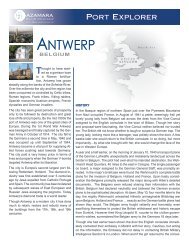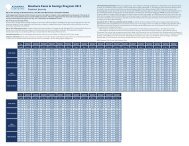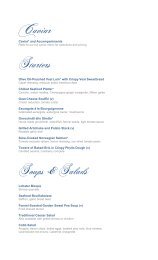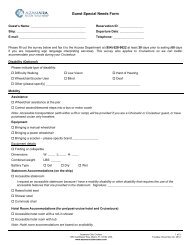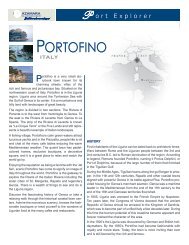Dubai Museum - Azamara Club Cruises
Dubai Museum - Azamara Club Cruises
Dubai Museum - Azamara Club Cruises
Create successful ePaper yourself
Turn your PDF publications into a flip-book with our unique Google optimized e-Paper software.
DUBAI<br />
UNITED ARAB EMIRATES<br />
Like an oasis in the desert, <strong>Dubai</strong> is a surreal<br />
land of contrasts. Old Arab traditions<br />
blend with modern realities of comforts, luxuries<br />
and values. Islamic culture and heritage, traditions and customs<br />
both old and new make up the charm of the most populous<br />
city in the United Arab Emirates. <strong>Dubai</strong> defies its surroundings<br />
with seemingly endless skyscrapers, five and even seven-star hotels,<br />
artificial islands, and an indoor ski slope that dot the desert<br />
emirate. Perhaps only the permanent feature of <strong>Dubai</strong> is change:<br />
every year the landscape changes with thousands of newly constructed<br />
buildings and infrastructure. Even the land itself changes:<br />
two inaugural land reclamation projects, The Palm Islands<br />
and The World, have emerged from the sea as some of the most<br />
sought after real estate in <strong>Dubai</strong>. Also known as the Venice of<br />
the (Persian) Gulf, <strong>Dubai</strong> is the most independent of the emirates,<br />
defying the influence of federal institutions to regulate its trade.<br />
Its residents were fed by the idea that human beings, whatever<br />
their religion, will put aside their differences in pursuit of profit.<br />
<strong>Dubai</strong> was originally two towns: Deira to the east and Bur <strong>Dubai</strong> to<br />
the west. If Deira is characterized as the city’s commercial heart,<br />
then Bur <strong>Dubai</strong> is the city’s historical soul. The two towns are<br />
separated by <strong>Dubai</strong> Creek. It was here, on the Creek’s banks that<br />
the city grew from a tiny Persian Gulf trading hub into a megalopolis.<br />
Arab wooden boats called dhows carry goods to trade down<br />
the river, alongside the major developments along the creek’s<br />
banks that hurl the city into the twenty-first century. Beginning<br />
in the 1960s, an influx of trade, investment, and publicity flooded<br />
the city to make it one of the most spectacular emirates of the<br />
UAE. Today the emirate needs little introduction, as <strong>Dubai</strong> has<br />
become synonymous with over-the-top architecture, international<br />
trade, and fantastic beaches. In addition to its jaw-dropping landscape,<br />
<strong>Dubai</strong> plays host to dozens of international festivals and<br />
sports competitions each year. Today <strong>Dubai</strong> is home to a list<br />
of superlatives that constantly grows longer: the tallest buildings,<br />
the largest malls, most luxurious hotels, and most expensive real<br />
estate. These days it seems that <strong>Dubai</strong>’s only competition for<br />
growth is itself.<br />
P ort Explorer<br />
HISTORY<br />
<strong>Dubai</strong>’s past – and that of the entire United Arab Emirates<br />
– is also a tale in the history of trade, tribes, and Islam in<br />
the Middle East. Arab tribes entered the region around<br />
500 B.C., but there were no permanent settlements until<br />
irrigation techniques and the domestication of the camel<br />
enabled tribes to stay in the area. The pearl and agricultural<br />
industries prompted further urbanization, making<br />
<strong>Dubai</strong> and surrounding coastal towns into maritime powerhouses.<br />
In 630 A.D., messengers from the Prophet Muhammad<br />
arrived, ushering in the widespread conversion<br />
to Islam. For the following three centuries, the UAE was<br />
the staging ground for political and religious conquests,<br />
paving routes for trade and contact in the Gulf. Until the<br />
1830s, <strong>Dubai</strong> was part of a conglomerate of Arab commercial<br />
towns that interacted with local merchants and<br />
European traders, especially the Portuguese, Dutch, and<br />
British. European powers tried to control <strong>Dubai</strong>’s strategic<br />
coast, resulting in the British finally gaining control in<br />
1766.<br />
In the 1830s, Sheikh Maktoum Bin Asher moved into Bur<br />
<strong>Dubai</strong> and established the Al-Maktoum dynasty that continues<br />
to rule today. In 1892, Sheikh Maktoum signed a<br />
landmark trade agreement with the British. Two years<br />
later, he established a tax exemption for foreign merchants,<br />
and in 1903, <strong>Dubai</strong> became the main port of call<br />
for British steamships in the Gulf. Its status as a dutyfree<br />
port saved the city when its natural pearling industry<br />
crashed in the 1930s with the invention of artificial pearls.<br />
Sheikh Rashid Bin Saeed Bin Al-Maktoum developed the<br />
© 2010 maps.com
facilities along <strong>Dubai</strong> Creek to strengthen the duty-free port’s<br />
“re-export trade” of cheaply imported goods…as well as its<br />
black market for gold smuggling.<br />
The 1966 the discovery of oil lit a fire to the already hot economy.<br />
In 1968, the British withdrew forces from the Gulf, allowing<br />
the local rulers to establish their own government. In<br />
1971, leaders formed the United Arab Emirates, and <strong>Dubai</strong><br />
became the free trade center of the union in the subsequent<br />
years. Sheikh Rashid oversaw the transformation of <strong>Dubai</strong>’s<br />
DUBAI PLACES OF INTEREST<br />
1<br />
Step back in time along the <strong>Dubai</strong> Creek Waterfront,<br />
which separates Deira from Bur <strong>Dubai</strong>. The creek literally<br />
links <strong>Dubai</strong>’s present to its history, as the water guides<br />
traditional wooden boats, known as dhows, to the city center.<br />
2<br />
6<br />
7<br />
Learn about the emirate’s history at the <strong>Dubai</strong> <strong>Museum</strong>,<br />
which occupies the former Al-Fahaidi Fort on the <strong>Dubai</strong><br />
side of the Creek. The museum exhibits a chronological history<br />
of <strong>Dubai</strong> from the 19th century onwards including a recreation<br />
of the <strong>Dubai</strong> souq as it looked in the 1950s. There<br />
are also exhibits on the flora and fauna of <strong>Dubai</strong>, Bedouin life,<br />
seafaring life and the area’s archaeology.<br />
economy and infrastructure until his death in 1990. His son,<br />
Sheikh Maktoum, continued his father’s legacy until his own<br />
death in 2006, leaving <strong>Dubai</strong> as the fastest growing city in<br />
the world. Today <strong>Dubai</strong> plays host to countless festivals and<br />
sports competitions, including the renowned <strong>Dubai</strong> Desert<br />
Classic golf tournament. The city knows no limits on its potential<br />
growth, and it shows no signs of stopping in the twentyfirst<br />
century.<br />
3<br />
Bastakia is a heritage neighborhood in Bur <strong>Dubai</strong> that<br />
was originally built by Persian merchants who settled in<br />
the area in the late 1800s. Limestone homes and restored<br />
wind towers line the narrow pedestrian streets that were<br />
largely neglected until the area was restored.<br />
4<br />
First built in 1900, the <strong>Dubai</strong> Grand Mosque has been<br />
rebuilt several times, yet has always been a center of<br />
worship and cultural life in the city. Most recently reconstructed<br />
in 1998, the mosque has the tallest minaret in <strong>Dubai</strong>. Non-<br />
Muslims are not allowed to enter the mosque, but they can<br />
visit the minaret and outside areas.<br />
© 2010 maps.com
5<br />
Gold Souq, is probably the largest<br />
such market in Arabia and should<br />
be at the top of any “must see” list for<br />
<strong>Dubai</strong>.<br />
6<br />
In 1896, a coral-block home with<br />
four wind towers was constructed<br />
for the ruling family, Sheikh Saeed Al<br />
Maktoum. Today Sheikh Saeed’s<br />
House has been restored as a museum<br />
of pre-oil times. It sits beside the Creek<br />
on the <strong>Dubai</strong> side, near Port Rashid.<br />
7<br />
Learn about <strong>Dubai</strong>’s maritime history<br />
at the Heritage and Diving<br />
Village in Al Shindagha. The Heritage<br />
area features traditional craft demonstrations,<br />
while the Diving Village displays<br />
the pearl diving history of <strong>Dubai</strong>.<br />
Beyond Central <strong>Dubai</strong><br />
The 39 floor World Trade Center once<br />
was the tallest building in <strong>Dubai</strong>. There<br />
is a viewing gallery on the 37th floor for<br />
those who want a bird’s-eye view of the<br />
city.<br />
Out of the waters near <strong>Dubai</strong> has<br />
emerged Jumeirah Palm Island, the<br />
first of three planned reclaimed landmasses.<br />
The project will add over 500<br />
kilometers to <strong>Dubai</strong>’s coastline and is the<br />
most ambitious land reclamation project<br />
in the world.<br />
As if skyscrapers and artificial islands<br />
were not enough … it even snows in the<br />
desert at Ski <strong>Dubai</strong>, an indoor ski center<br />
in the Mall of the Emirates. The facility<br />
has a restaurant overlooking the slope<br />
where you can marvel at the improbable<br />
wonderland.<br />
In 1998, UNESCO named the neighboring<br />
emirate of Sharjah the capital of<br />
the Arab world for its preservation of its<br />
traditional architecture and culture with<br />
historical museums, mosques, and heritage<br />
areas.<br />
SHORE ExCURSIONS<br />
To make the most of your visit to <strong>Dubai</strong> and surrounding areas we suggest you take<br />
one of the organized Shore Excursions. For Information concerning tour content<br />
and pricing, consult azamaraclubcruises.com or contact the onboard Shore Excursion<br />
Desk. When going ashore, guests are advised to take with them only the items<br />
they need and to secure any valuables.<br />
LOCAL CUSTOMS<br />
Bargaining: Haggle hard anywhere in the souq but don’t expect the prices of things<br />
like gold or electronic goods to come down by more than 10 - 15%. Antiques and<br />
crafts may come down a bit more.<br />
Tipping: Tips are not generally expected in the UAE, though since most waiters<br />
receive extremely low salaries they would certainly be appreciated. The service<br />
charge added to your bill usually goes to the restaurant, not the waiter.<br />
LOCAL CUISINE AND DRINk SPECIALTIES<br />
Arabic food reigns supreme in <strong>Dubai</strong>. Indian, Pakistani, and Lebanese restaurants<br />
abound, as well as every international cuisine imaginable at <strong>Dubai</strong>’s vast array<br />
of hotel restaurants. Be prepared to eat “mezze” style, in which a variety of appetizers<br />
arrives at your table at the same time, rather than a series of full-course<br />
dishes. Shawarma is an Arabic sandwich made with pita bread, lamb or chicken,<br />
and topped with tomatoes, cucumber, lettuce, and hummus. Falafels are a delicious<br />
fried mix of ground chickpeas and spices, which can look like a croquette or<br />
cutlet. Try it as an appetizer, in a sandwich, or as a side dish.<br />
Non-alcoholic drinks such as soft drinks, fruit juices and mineral water are available<br />
throughout the country. Alcohol can only be sold in restaurants and bars attached<br />
to hotels. The selection is what you would expect to find in any well-stocked<br />
bar. Bottled water is recommended.<br />
SHOPPING<br />
When a city has an annual Shopping Festival, you know the opportunities will be<br />
endless… <strong>Dubai</strong> City Center is a popular destination with hundreds of shops. The<br />
Mall of the Emirates was the largest mall in the world until the <strong>Dubai</strong> Mall opened in<br />
November 2008 in Downtown Bur <strong>Dubai</strong>. With over 1200 stores, an Olympic-size<br />
ice rink, and a Fashion Catwalk, it will be difficult to not find something to purchase<br />
at these malls.<br />
For a taste of traditional market culture in <strong>Dubai</strong>, visit one of the many souks.<br />
<strong>Dubai</strong> has souks specializing in gold, spices, perfumes, and textiles. Besides the<br />
title goods at the souks, popular souvenirs in <strong>Dubai</strong> include Persian rugs, pearls,<br />
and jewelry. Be prepared to haggle.<br />
LOCAL CURRENCY<br />
The UAE Dirham (Dh) is divided into 100 fils. You will also hear the currency occasionally<br />
referred to as rupees. Notes come in denominations of Dh 5,10, 50, 100,<br />
200, and 500. Coins are Dh 1,50 fils, 25 fils, 10 fils and 5 fils. Foreign exchange<br />
rates fluctuate. There is also a slight variation for cash or traveler’s checks.<br />
POST OFFICE AND TELEPHONE FACILITIES<br />
There is a Post Office available at the cruise terminal.<br />
Dial the following access numbers to use a personal calling card:<br />
AT&T: 0.800.121 or 0.800.161<br />
MCI: 0.800.111
TRANSPORTATION<br />
The most popular way to get around <strong>Dubai</strong> is by taxi. There<br />
are metered taxi services on either side of <strong>Dubai</strong> Creek. The<br />
emirate’s bus system is also reliable and extensive. Local<br />
buses operate out of the main stations in both Deira and Bur<br />
<strong>Dubai</strong>. Numbers and routes are posted on the buses in English<br />
as well as Arabic.<br />
To go from Deira to Bur <strong>Dubai</strong> across <strong>Dubai</strong> Creek, take an<br />
abra or small water taxi. You can also hire a private abra with<br />
an operator for a larger fee.<br />
TOURIST INFORMATION<br />
There is a Tourist Information Desk available at the cruise<br />
terminal.<br />
USEFUL WORDS AND PHRASES<br />
Good morning - sabah al-kheir<br />
Good afternoon/evening - masa’al-kheir<br />
Thank you - shukran<br />
You’re welcome - afwan/al-afu<br />
Yes - ai/aiwa/na’am<br />
No - la’<br />
How much is that? - bcham hatha<br />
Where is the washroom (toilet)? - wein al el-Hammam<br />
__________________________________________________________________________________<br />
__________________________________________________________________________________<br />
__________________________________________________________________________________<br />
__________________________________________________________________________________<br />
__________________________________________________________________________________<br />
__________________________________________________________________________________<br />
__________________________________________________________________________________<br />
__________________________________________________________________________________<br />
__________________________________________________________________________________<br />
__________________________________________________________________________________<br />
__________________________________________________________________________________<br />
__________________________________________________________________________________<br />
__________________________________________________________________________________<br />
__________________________________________________________________________________<br />
__________________________________________________________________________________<br />
__________________________________________________________________________________<br />
__________________________________________________________________________________<br />
__________________________________________________________________________________<br />
__________________________________________________________________________________<br />
__________________________________________________________________________________<br />
__________________________________________________________________________________<br />
This information has been compiled for the convenience of our guests and is intended solely for that purpose.<br />
While we work to ensure that the information contained herein is correct, we cannot accept responsibility for any changes that may have taken place since printing.<br />
© RCCL 2010 - All rights reserved.



